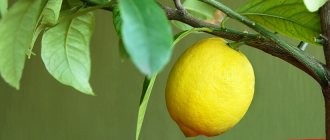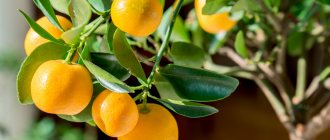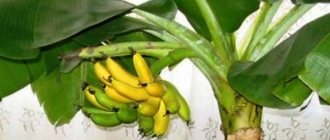The exotic fruit Passion Fruit (Passiflora) can be grown from a seed in an apartment. If it is not difficult to maintain the temperature in your home above +22 degrees, and there is a desire to carry out basic agrotechnical measures, then you can safely take on breeding a tropical species.
What are the nuances of seed preparation? What humidity and soil does Passion Fruit prefer? Growing an evergreen vine with luxurious flowers at home is an interesting activity. If an amateur gardener buys a self-pollinating variety, then it is quite possible to wait for exotic fruits to appear and surprise family and friends.
How and where does passion fruit grow in natural conditions?
Edible Passionflower is native to South America. Under natural conditions, it is a woody vine or a wide bush. Cultivated varieties are grown in open ground in the vast expanses of Central Asia and Australia. Family Passionaceae, evergreen plant.
At home, passion fruit does not grow as long as other species; the average lifespan of an exotic vine is about six years. For this reason, flowering and fruit formation begins early: already six months after germination. In the third season, the number of fruits decreases. It is useful to know about this feature of a tropical species.
Description of passionflower
This flower can be either a herbaceous plant or an evergreen climbing shrub. This annual or perennial plant has woody shoots. The simple dark green leaves can be whole or lobed. Quite large axillary flowers, star-shaped and brightly colored, grow on long stalks. The diameter of this very spectacular flower is 10 centimeters. Such a flower has exactly 5 petals (the number of wounds of Christ), the same number of sepals, there are quite large bracts, and in the center there is an ovary with 3 stigmas. Around these ovaries there are exactly 5 stamens with fairly large anthers. Most species have very fragrant flowers, but they fade relatively quickly. As a rule, flowering is observed in July–October. After flowering, fruits are formed that reach a length of 6 centimeters. In most species, such fruits can be eaten. This plant grows very quickly and is not capricious, so it is quite popular among gardeners who grow it as an ampel plant.
How to choose a fruit for planting
Not all Passiflora varieties take root well at home. A beautiful vine with lush foliage and fantastic flowers can be obtained by planting Cavalier Star and Passiflora edulis (Passion Fruit). Each type has its own characteristics.
Passiflora blue
Helpful information:
- duration of flowering - from the first months of spring to September-October;
- the buds are large: from 7 to 9 cm, the smell is similar to feijoa;
- the shade of the petals is white-blue;
- each flower lives for about a day;
- orange fruits, reminiscent of a chicken egg, ripen for one and a half to two months;
- active growth, in nature the vine stretches up to 10 m;
- At home, it develops well on southern windows and produces abundant flowering. In shaded rooms the buds are small, in small quantities;
- blue passionflower tolerates cultivation well in the fresh air: in a private house you can keep a flowerpot with an exotic plant in the garden from April to October;
- Pollination is carried out by bees.
passion fruit
Edible passionflower - features:
- dark green leaves that look like blades;
- high decorativeness of the plant;
- lush evergreen vine;
- flowers are violet-white, large – up to 10 cm;
- the fruits are purple-burgundy in color, round, large (about 7 cm), the flesh is rich yellow, juicy;
- passion fruit loves the sun and grows well in homes and winter gardens;
- The heat-loving species prefers temperatures in summer from +23 to +26 degrees, in winter from +16 to +18 C;
- The temperature must not be allowed to drop below + 5 degrees: the plant dies.
For planting seeds, choose passion fruits:
- ripe;
- no damage or stains;
- without rotten parts;
- large;
- not pressed.
Important! To obtain Passion Fruit fruits at home, experienced flower growers advise buying the self-pollinating Frederik variety. In other cases, you will need two plants with male and female flowers.
Types of Granadilla or passion fruit
- Granadilla or sweet passion fruit (P. ligularis) - the diameter of the white petals ranges from 8 to 12 cm. The fruits are orange-red. Delicious passionflower;
- Granadilla or giant passion fruit (P. quadrangularis) is a tall passion flower, reaching 15 meters. The diameter of the flowers is from 12 to 15 cm. The largest-fruited passiflora bears yellowish fruits up to 30 cm in size;
- Brazilian passion fruit (P. alata) has deep orange or red flowers and slightly smaller fruits than the giant granadilla. Can overwinter indoors.
How to plant seeds
First, the seeds are separated from the fruit, washed, dried, and part of the top layer is removed. Be sure to choose a suitable soil, taking into account the recommendations, and make a drainage layer (from 2 to 3 cm) at the bottom of the flowerpot. Plastic containers or briquettes made from natural coconut fibers are suitable for planting. Planting seeds is not difficult, you just need to strictly follow the rules given below.
At home, many amateur gardeners successfully grow various exotic fruits. It is easy to get trees and vines from the seeds: lemon, lychee, orange, mango, grapefruit, avocado, date palm. Even in the absence of fruits, the plants delight with bright greenery and a beautiful crown. After grafting, some exotic species begin to set fruit. Tropical plants look no less impressive than the usual highly decorative indoor flowers: Geranium, Hippeastrum, Dipladenia, Primula, Hyacinth, Decembrist, Uzambara violet, Azalea, Cyclamen, Amaryllis.
Seed preparation
The planting material will most likely sprout if the seeds are properly processed:
- engaged in the preparation and planting of a tropical plant immediately after extracting the seeds from the fruit;
- rinse the seeds, dry with a towel, and lightly rub each side with fine sandpaper or a nail file. It is important to remove some of the top layer to facilitate seed germination;
- then soak the prepared planting material in fresh milk at room temperature;
- You can soak passionflower seeds in a growth stimulant, which is sold in an agricultural store. Suitable preparations are Gibberelin (the base is kept for no more than three hours) and Kornevin (the seeds are soaked according to the instructions).
Preparing the pot and soil
To germinate seeds, you will need a multicomponent substrate. Ingredients: peat, chalk, deciduous soil, mineral fertilizers, clay. All ingredients for the soil mixture are taken in equal quantities. Drainage is made from clay shards, broken bricks, pebbles, or expanded clay.
The second option is to buy a coconut fiber briquette. Before germinating passionflower seeds, fill the base with warm water, allow it to swell (approximately 5 times its original volume), and check whether the excess liquid is well drained. Next, loosen the resulting base with your fingers and plant one seed in each briquette if the briquette is small.
Landing rules
Note to flower growers:
- lightly moisten the soil, dig a small hole (about 1 cm), place the seed after pre-treatment), sprinkle with soil, water moderately;
- to preserve, cover the container with passionflower seeds with a plastic bottle, the neck and a third of the container have been cut off;
- under the “hood”, in the mini-greenhouse, an optimal microclimate is created so that the passion fruit seed germinates faster;
- The greenhouse is placed in a warm room, with a temperature of about +22 degrees, with sufficient light. the sun's rays should not fall directly on the mini-greenhouse so that the humidity is always normal;
- every two or three days, open the container for a few minutes, collect drops of water on the bottle, ventilate the greenhouse, and cover the soil again;
- the timing of the appearance of sprouts varies significantly - from two weeks to a month: in most cases, the indicator depends on the ripeness of the fruit and the quality of seed treatment before planting;
- If after a couple of months there are still no shoots, you will have to dispose of the soil and unsprouted seeds and repeat the process again.
History of the discovery of a flower
The homeland of most passionflower species is the tropical and little-explored forests of South America; some types of flowers are also found in Asia and Madagascar. Europe became acquainted with this plant only after the conquest of the New World.
The passionflower flower has a complex and original structure - at the top of the petals there is a “crown” consisting of long scales, behind which there are large stamens. Even higher there is a pistil and 3 stigmas (see photo of edible passionflower). Because of this appearance, missionaries who came to America and the Catholic Church considered the flower to be Christ's crown of thorns and banned its study. The first description of passionflower was made only in the twentieth century.
How to care
After passion fruit seeds germinate, the greenhouse is ventilated more often and removed after a few days. It is important that the soil does not dry out, but there is no need to moisten the substrate too much. There are other nuances of growing passionflower at home: the care features are described below.
Location
The container with passion fruit seedlings is placed in a bright room, away from drafts. It is important that the room is not too hot and the sun's rays do not fall directly on the sprouts. It is convenient to place the container with passion fruit on a coffee table or a stable stand near the window.
Warning! The room with the seedlings must not be allowed to be too damp and cold. Ventilation is carried out through the window; the windows are not opened.
Temperature
Passionflower grows in natural conditions in countries where it is hot and humid. The plant should not be placed in a room with low temperature, dampness, or lack of light: fungus develops and disease resistance decreases. When putrefactive flora appears, fungicides are used.
In summer, the optimal temperature for growing Passion Fruit at home is from +23 to +26 degrees. The liana grows well even at +20°C..+21°C, but the flowering will not be as bright, and the growing season will be less active. If the home is cool, the fruits are unlikely to appear.
There is no clearly defined period of rest and passionflower, but most gardeners recommend creating suitable conditions for rest in winter. It is useful to place the evergreen vine in a cooler room (average values are from +16 to +18 degrees), reduce watering, and fertilize once a month in a minimal amount. The complex eco-fertilizer Biohumus (liquid form), diluted according to the instructions, is suitable for fertilizing the soil.
Lighting
A heat-loving plant needs a warm room with plenty of light. The evergreen passionflower vine grows well in the presence of light shade, even in shaded areas, but without the optimal level of lighting, the buds become smaller and the flowering is not as abundant.
Watering and humidity
Important points:
- The tropical plant loves a moist environment; in dry soil, all types of passionflower grow poorly, bloom poorly and rarely bear fruit.
- For watering you need well-settled liquid, slightly warm.
- Water the tropical plant abundantly, but wait until the top layer dries.
- The lower the room temperature, the less frequently the flower is watered. In winter, when the flowerpot is moved to a cool room, the frequency of watering is reduced to once every 7–8 days.
- Passionflower loves warmth, but grows well at average temperatures: about +22 degrees. In this case, the soil is not moistened as abundantly as in hot weather, otherwise rot may occur.
- The drainage layer is an essential element for proper drainage of liquid from the flowerpot. Expanded clay, pebbles, broken bricks, clay shards are suitable materials. The holes in the bottom should be of medium size. You need to check whether small elements are blocking holes for water drainage. The thickness of the drainage layer is about 2–3 cm.
Many decorative foliage indoor flowers love moisture, need regular watering, and dry out and turn yellow when there is a lack of liquid. It is useful to know about this nuance for amateur gardeners who plan to plant other evergreen trees, vines and shrubs at home: Monstera, Fern, Ficus, Screw Palm, Ledeburia, Mother-in-Law, Asparagus, Calathea, Maranta, Croton.
Transfer
The procedure is carried out as the underground and above-ground parts increase. The liana stretches out quite quickly, the roots entwine the earthen ball, and almost every year, in the first three to four years, the plant will have to be replanted.
The flowerpot should be large, approximately 5 cm larger than the previous one. If there is not enough space for roots in the pot, flowering is not as abundant and shoot growth is slow. You need to know when to stop; you shouldn’t plant a young vine right away in a large tub. The flower is replanted in mid-spring - early summer. In adult passion fruit, instead of transshipment, you can replace 3 to 5 cm of the old substrate with a new one in the flowerpot. When moving a large plant, act carefully, making sure not to destroy the earthen lump.
Reproduction
Cultivation of the tropical passionflower vine in the home is carried out using cuttings or root shoots. If you manage to get the fruits, you can grow a new vine from the obtained seeds.
The simplest and most reliable method is cuttings:
- Rooting of cut shoots with two or three leaves is carried out in a nutrient substrate, with regular watering, in a room with a moderate temperature: about +21..+22 degrees.
- You can create a greenhouse for the speedy germination of roots.
- The process is activated with the help of growth stimulants: Kornevin, Heteroauxin.
- After rooting, the young plants are transplanted into a flowerpot in a permanent place.
- In most cases, the grown vines begin to bloom as early as next year.
Fertilizers and fertilizers
At all stages of development of a tropical plant, it is useful to add organic matter and mineral components. With proper feeding, the vine quickly gains green mass and the stems actively stretch.
Vermicompost is an excellent feeding option for growing passion fruit. Biofertilizer does not burn roots and is suitable for use when growing seedlings. It is important to choose a liquid concentrate and dilute it according to the instructions. Use the product in moderation, once every 14 days.
Trimming
With good care, passionflower grows actively, and already at a height of about 10 cm you need to build a support. The branches are actively weaving, it is useful to periodically enlarge the structure so that the bush is beautiful and the shoots do not fall from the support. The branches are flexible and it is easy to shape the tropical plant into the desired shape.
Passion fruit is an evergreen vine; the plant grows quite actively, stretches out, entwines the support, and produces many side shoots. Old stems do not bloom flowers and fruits; they are periodically pruned so that the elements do not take away the juices from younger branches. Formative pruning is carried out for shoots whose length has reached half a meter. If necessary, remove broken, rotten branches from the vine.
The procedure is carried out in March. Cut shoots are suitable for cuttings.
Formation of the passion fruit crown:
Liana pruning is usually carried out in the spring; if a transplant is performed, the procedures are combined. Branches exceeding 50 cm are cut by half or 1/3, which stimulates active branching. If the plant has aged and many bare branches have appeared, pruning is carried out in parts, leaving fragments at least 5 cm long. Pruning in parts means that all bare branches are not removed at once in one go, since such radical pruning can lead to stress and weakening of the plant. Pruning is carried out in stages, giving the passion fruit the opportunity to grow new shoots and foliage.
For normal development, passion fruit requires support from rings, ladders or stretched trellises.
Is it possible to get fruits and how to do it
Flowering of young passion fruit occurs quite quickly: many vines throw out original buds already in the first year after the first season of life. A young vine often reaches 1 m or more.
For active flowering and the appearance of juicy fruits on a Passion Fruit tree, you will need a self-pollinating variety or artificial pollination, even on dioecious plants. You need to carefully transfer pollen from male flowers to female flowers and hope for a positive result.
Don't despair if you can't grow fruit. The evergreen vine Passion Fruit, even without exotic fruits on its branches, is highly decorative. It is much easier to achieve the release of buds; the flowers of a tropical plant are unusual, large and very beautiful.
Application in medicine
Passion fruit has been used for a long time in folk medicine; decoctions and tinctures are made from the fruits, flowers, seeds, peel and leaves, which help with various health problems:
- headaches and insomnia;
- climacteric disorders;
- chronic alcoholism;
- whooping cough;
- hypertension;
- liver diseases;
- convulsions;
- anxiety states;
- bronchial asthma;
- high blood pressure;
- haemorrhoids;
- muscle spasms;
- gastrointestinal disorders;
- inflammation;
- burns.
Passion fruit infusions are used as an antifungal, antiseptic and antispasmodic.
Diseases and pests
Good care is the best prevention of various types of damage to indoor plants. Like many vines and decorative deciduous species, Passion Fruit at home is faced with the effects of pathogenic flora against the background of stagnant water.
Important points:
- Root rot is a consequence of excessive watering at average temperatures.
- The fungus dies after using fungicides: Skor, Trichodermin, Fundazol, Maxim, Fitosporin, Bordeaux mixture, Abiga-Pin.
- Be sure to remove the old soil, carefully wash the roots, also apply an antifungal composition to the underground part of the plant, replant it in a new container, and dispose of the old flower pot.
- It is useful to treat the window sill and window frame, stand or other surface where the flowerpot was located with fungicides.
Pests
From open windows, from contaminated soil when buying a new flower, or from other indoor plants, parasitic insects get onto the passion fruit. In most cases, owners identify the following pests: scale insects, aphids and spider mites.
What to do:
- Move infected plants to a separate room for quarantine. A simple action prevents pests from settling on other specimens in the green corner.
- Carry out disinfestation and anti-tick treatment using effective chemicals and biological agents. It is imperative to protect the body from the influence of toxic drugs: a respirator, rubber gloves, closed clothing, a hat, plastic glasses.
- To combat insects, modern insecticides are used: Fitoverm, Aktara, and in case of severe infestation of a flower - Aktellik. When spider mites infest the plant, the plant is treated with acaricides: Fufanon, Neoron, Antiklesch.
- If the number of parasites is small, it is useful to use a strong solution based on laundry soap: after applying a sticky, thick mass, the pests suffocate under the film, it is easier to remove adults and larvae.
- A soap solution is indispensable when fighting scale insects: females stick tightly to the surface of leaves and shoots, and it is impossible to separate the pests without damaging the greenery. After using a soapy solution, pests are easier to clean off with an old toothbrush.
- To prevent the infestation of ticks and harmful insects, it is useful to spray indoor flowers with garlic tincture or a decoction of tobacco leaves a couple of times a month. Supports the protective power of indoor flowers with Succinic acid for plants and the safe drug Fitosporin. Watering the soil and treating the leaves is carried out strictly according to the instructions.
Growing passion fruit (edible passionflower) at home requires the amateur gardener to pay attention to the tropical plant. Under suitable conditions, the vine blooms beautifully, and in some cases it is possible to obtain exotic fruits.
How to plant a passion fruit seed and how to care for the plant? Answers in the next video:
Use in cooking
Passion fruit is eaten differently in different countries:
- on the Hawaiian and Philippine islands the fruits are pierced and the juice is drunk;
- in the Dominican Republic, fresh fruits are eaten with sugar;
- in Sumatra they use fruit juice to make syrup;
- the Vietnamese prepare a popular dessert made from passion fruit and honey;
- in Brazil, the seeds are used to decorate baked goods, and the juice is used to make mousses;
- in Australia, sweet sauces are prepared from the fruits, passion fruit is served with ice cream, cheesecake and the airy pavlova dessert. The juice is used to prepare the refreshing drink Passiona;
- in Mexico, passion fruit is seasoned with lime and red pepper;
- in Peru, sour passion fruit is added to the national seafood appetizer called ceviche;
- In South Africa, passion fruit is added for flavor to yoghurts, carbonated drinks, sweet pastries, and multivitamin and tropical juice mixtures are prepared.
The fruit is usually eaten raw, cut into two halves and the pulp scooped out with a spoon. An aromatic juice is prepared from the fruits, which becomes even tastier if mixed with orange juice. Fruits are used as a filling for baked goods, an addition to cocktails, ice cream, yoghurts and various desserts. Passion fruit is added to salads and sauces, and the pulp is included in liqueurs.
Passion fruit dessert
Ingredients:
- 50 g Philadelphia cheese;
- 250 g condensed milk;
- lemon;
- 1 passion fruit;
- 150 ml heavy cream 30%;
- 20 ml milk;
- 1 quail egg.
Preparation:
- Cut the passion fruit and scoop out the pulp with a spoon, place in a blender bowl, add cheese, milk and egg.
- Wash the lemon and cut it into 2 parts, squeeze the juice of one half into a blender, add condensed milk and beat everything until smooth.
- Place the whipped mixture in a bowl and add the cream, stirring gently from top to bottom using a spoon.
- Divide the mixture into portion forms, grate the zest of the remaining half of the lemon on a fine grater and decorate the dessert. Place the molds in the refrigerator for half an hour. Serve chilled.
Passion fruit punch with rum
Ingredients:
- 150 g passion fruit pulp;
- 300 ml white rum;
- 2 glasses of ice;
- 600 ml lemonade;
- 150 ml orange juice.
Preparation:
- Mix orange juice, rum and passion fruit pulp in a decanter. Cover with film and leave in the refrigerator for an hour.
- Combine the mixture with lemonade and pour into tall glasses with ice.











